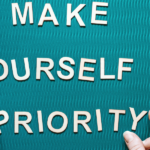It would be ideal if traumatic healing could happen by following a few simple steps. Unfortunately, though, the experience of emotional recovery often feels more like being in an M. C. Escher painting where every pathway takes us to where we were at the beginning.
It doesn’t have to be this way, though.
Healing emotional pain is possible for any trauma survivor, no matter what they’ve been through.
For many, emotions come from an unexamined world. The inner life is something many don’t become aware of until there’s a threat from the outside and we feel like we have nowhere to hide except inside ourselves. But then again, even emotionally fluent people struggle to process traumatic memories, and trauma can take even the most introspective of introverts to a new level of isolation.
Trauma throws us into a new place in the emotional world, and we’re always unprepared for the hold it will take.
Trauma survivors find themselves in an ongoing battle, even when the threat has dissipated. Panic attacks become the new monsters that creep up out of nowhere. Attention, core beliefs, and the will to live to emerge as the new battlegrounds. Hope, love, empathy, and change are the only weapons we can rely on to defeat the invading malice.
The wounds of trauma can run so deep that they penetrate beyond our awareness. Some survivors, for example, inexplicably develop negative associations with a unique sound, only to realize later that the same noise was playing during the traumatic event (i.e. a song in the background when receiving devastating news, or a loud pop that mimics an explosion). Strange dreams or fantasies can also give insight into inner emotional turmoil. Socially, trauma survivors can start to behave differently, even around those they care about. There’s a sense of being at the mercy of erratic thoughts and feelings, and unable to control them. This can cause behaviors like snapping at loved ones over seemingly trivial issues because they were unaware they were becoming overwhelmed.
Emotional Pain’s Distortion
Emotional damage is impossible to measure. The number of sleepless nights or hours spent crying or living in fear fails to illuminate how emotional trauma breaks a person’s world.
The number of pieces into which a person’s heart breaks cannot be counted. Nor do they need to. One is all it takes.
Yet our society views emotions as a secondary concern. There’s a rationale behind this – unlike physical wounds, emotional damage cannot kill. But where physical wounds heal, emotional health can be difficult to repair.
Emotional pain distorts the sufferer’s worldview. It invades, pervades, demands confrontation, and exhausts the sufferer’s every available resource. Everything is given to the traumatic memory; nothing is left over for the self. The emotional pain that seeps in can torment someone so severely that it can make them feel like living is somehow worse than death.
It can be difficult to eat, sleep, work, and function. Maintaining relationships is a new struggle, as does believing in the dreams we hold within ourselves. Healing emotional pain is just as critical to trauma recovery as repairing a physical wound.
But emotional pain’s only power is that it’s a lie about how the world works, that entered the mind disguised as truth. Recognizing this can help us begin to heal.
We need to have trust in people, to feel safe walking down the street or even in our own homes. We need to fill our imaginations with dreams instead of nightmares and have the opportunity to live a joyful life. To do so, we must first heal the emotional pain inside ourselves.
Recovery Guilt in Trauma Victims
One issue that needs to be addressed during the healing process is recovery guilt.
Recovery guilt is an extension of survivor guilt, which is where there’s a tragedy, and those who survive feel guilty that others died while they lived. Survivor guilt can be felt by anyone close enough to the tragedy that they feel guilty for surviving.
Recovery guilt builds on this by making survivors feel guilty for wishing to let the effects of the tragedy go. It’s almost as if there is a belief that holding onto the pain somehow keeps everything in check, but this just isn’t the case.
Trauma survivors need to know that it’s ok to hold onto the pain, and it’s ok to let it go. What’s not ok is giving up or feeling as though it’s inevitable that the pain will destroy you.
When trying to gain distance from the traumatic pain, it’s completely normal for trauma victims to feel guilty.
We feel the need to hide questions like ‘When is it ok for me to stop feeling bad?’ Or, ‘I’m exhausting from caring about this today.’ We feel like if anyone overhears these thoughts, or even if we say them out loud, then it means that the emotional pain isn’t real. However, it’s important to remember that the only reason we feel guilty for wanting to recover is that we’ve failed to realize how much traumatic pain exists in the first place – the need to escape pain does not arise without pain being present.
Survivors will have a difficult enough time disconnecting from the pain and should always be given feel that they have the freedom to move toward joy whenever they wish.
Emotional Trauma Can Always Heal
To people on the outside, it may seem like the whole world has gone dark for someone who has suffered trauma, but those who have been through it know that there’s still a light that still shines even in the darkest times. It’s a light with the strength to hope for a world where violent acts of hatred no longer exist, where the worst thing that happened to us has no power to define us, and where our lives are run on joy and happiness and not fear and pain.
Remember that no matter what you’ve been through, trauma may have the power to change us forever, but it doesn’t have the power to torment us forever.
The memories persist, but in time, distance is gained. The terrible parts of the memory either fade away or morph into curiosity or empathy or activism, while the beautiful parts of the memory – the love, the strength, the change – begin to shine brighter as time goes on.
We can always look at the imaginary and natural worlds to help our emotions heal. Over the coming weeks, we’ll be releasing a 10-part series to help anyone use resources like art, exercise, and even humor to help mitigate emotional pain and allow joy back into their lives.
Make sure you follow us on Instagram and Facebook to get updated!
Stars of HOPE is a non-profit organization that uses art therapy and community resources to help survivors of mass tragedies hold onto hope during difficult times.
Visit our website to find out more.




